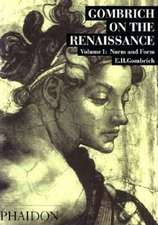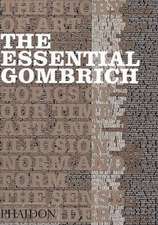The Uses of Images
Autor Leonie Gombrich, Ernst H. Gombrichen Limba Engleză Paperback – 15 mar 2000 – vârsta de la 13 până la 22 ani
Preț: 302.83 lei
Nou
Puncte Express: 454
Preț estimativ în valută:
57.95€ • 62.93$ • 48.68£
57.95€ • 62.93$ • 48.68£
Carte tipărită la comandă
Livrare economică 22 aprilie-06 mai
Preluare comenzi: 021 569.72.76
Specificații
ISBN-13: 9780714839691
ISBN-10: 0714839698
Pagini: 304
Ilustrații: 356 b&w illustrations, notes, index
Dimensiuni: 172 x 245 x 20 mm
Greutate: 0.75 kg
Ediția:Revised
Editura: Phaidon
Locul publicării:United Kingdom
ISBN-10: 0714839698
Pagini: 304
Ilustrații: 356 b&w illustrations, notes, index
Dimensiuni: 172 x 245 x 20 mm
Greutate: 0.75 kg
Ediția:Revised
Editura: Phaidon
Locul publicării:United Kingdom
Notă biografică
Sir Ernst Gombrich was one of the greatest and least conventional art historians of his age, achieving fame and distinction in three separate spheres: as a scholar, as a popularizer of art, and as a pioneer of the application of the psychology of perception to the study of art. His best-known book, The Story of Art - first published 50 years ago and now in its sixteenth edition - is one of the most influential books ever written about art. His books further include The Sense of Order (1979) and The Preference for the Primitive (2002), as well as a total of 11 volumes of collected essays and reviews. Gombrich was born in Vienna in 1909 and died in London in November 2001. He came to London in 1936 to work at the Warburg Institute, where he eventually became Director from 1959 until his retirement in 1976. He won numerous international honours, including a knighthood, the Order of Merit and the Goethe, Hegel and Erasmus prizes. Gifted with a powerful mind and prodigious memory, he was also an outstanding communicator, with a clear and forceful prose style. His works are models of good art-historical writing, and reflect his humanism and his deep and abiding concern with the standards and values of our cultural heritage.
Descriere
A study of the social functions of images, and their evolution. In this volume, the tenth in the series of his collected essays, Professor Gombrich returned to themes that long preoccupied him in his study of visual imagery of all kinds. Central to these pivotal essays is a consuming interest in the functions of images, and how these functions, in addition to the images themselves, evolve over time. In wide-ranging studies of both so-called 'high' and 'low' art - from fresco painting, altar painting, the International Gothic Style and outdoor sculpture to doodles, pictorial instructions, caricature and political propaganda - Gombrich examines a broad spectrum of key questions.
These include the role of supply and demand, competition and display, the 'ecology' of images, the idea of 'feedback' in the interplay of means and ends, and the ways in which developing skills in turn stimulate new demands. Gombrich explores in depth such specific aspects of the uses of images as the hanging of pictures and the use (or misuse) of images as historical evidence.
Extensive in its scope and surgically precise in its focus, The Uses of Images signifies yet another landmark corpus of work by the prolific Professor Gombrich, in a subtle but striking tour de force.
















